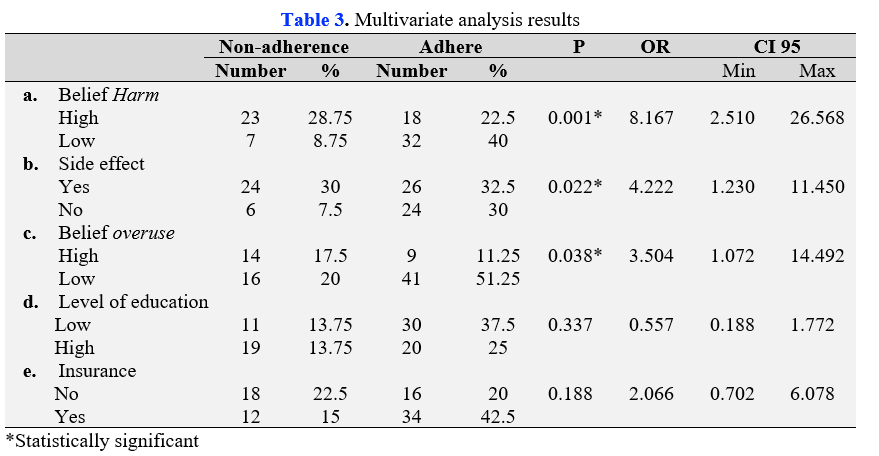Main Article Content
Abstract
Tuberculosis is an infectious disease that must be treated in the long term. One of the therapeutic efficacy factors in tuberculosis treatment is medication adherence by patients. Non-compliance to treatment leads to no achievement of treatment goals, increasing the risk of resistance, mortality, and morbidity. This study analyzed association factors that predicted the influence of the pulmonary tuberculosis patient’s non-adherence to anti-tuberculosis medicines in Surakarta Central General Hospital, Indonesia. The research was analytical research with a cross-sectional approach. The study samples were 80 respondents. The inclusion criteria were patients diagnosed with pulmonary tuberculosis in Surakarta Central General Hospital, aged >17 years old, and patients who received Anti-Tuberculosis Drugs for at least two months. This study used a questionnaire that has been validated. Data were analyzed by bivariate analysis (chi-square or Fisher) and continued by multivariate logistic analysis. Of 80 respondents, there were 30 respondents (37.5%) were non-adherence to taking Tuberculosis (TB) drugs. The predicted factors that influenced non-adherence in taking anti-tuberculosis drugs were beliefs about the medicine of the harm subscale (p = 0.001; OR = 8.167), suffering from drug side effects (p = 0.022; OR = 4.222), and beliefs about the medicine of overuse subscale (p = 0.038; OR = 3.504). The wrong beliefs of patients and side effects may influence patients’ adherence to TB medicines. Counseling and education are needed to improve patients’ beliefs and manage medicines’ side effects.
Keywords
Article Details

This work is licensed under a Creative Commons Attribution-NonCommercial 4.0 International License.
References
- Alhewiti, A. (2014). Adherence to Long-Term Therapies and Beliefs about Medications [Research article]. International Journal of Family Medicine. https://doi.org/10.1155/2014/479596
- Annisaa’, E., Ghofir, A., & Ikawati, Z. (2015). Hubungan Keyakinan dan Kepatuhan Terapi Pencegahan Sekunder terhadap Kejadian Stroke Berulang. Jurnal Managemen Dan Pelayanan Farmasi (Journal of Management and Pharmacy Practice), 5(2), 119–126. https://doi.org/10.22146/jmpf.141
- CDC. (2016). Treatment for TB Disease | Treatment | TB | Centers for Disease Control and Prevention. https://www.cdc.gov/tb/topic/treatment/tbdisease.htm
- Dahlan. (2017). Statistik untuk Kedokteran dan Kesehatan, Deskriptif, Bivariat, Dan Multivariat Dilengkapi Aplikasi Dengan Menggunakan SPSS (5th ed.). Salemba Medika.
- Fortuna, T. A., Rachmawati, H., Hasmono, D., & Karuniawati, H. (2022). Studi Penggunaan Obat Anti Tuberkulosis (OAT) Tahap Lanjutan pada Pasien Baru BTA Positif. Pharmacon: Jurnal Farmasi Indonesia, 19(1), Article 1. https://doi.org/10.23917/pharmacon.v19i1.17907
- Gatti, M. E., Jacobson, K. L., Gazmararian, J. A., Schmotzer, B., & Kripalani, S. (2009). Relationships between beliefs about medications and adherence. American Journal of Health-System Pharmacy, 66(7), 657–664. https://doi.org/10.2146/ajhp080064
- Horne, R., Weinman, J., & Hankins, M. (1999). The beliefs about medicines questionnaire: The development and evaluation of a new method for assessing the cognitive representation of medication. Psychology & Health, 14(1), 1–24. https://doi.org/10.1080/08870449908407311
- Karuniawati, H., Ikawati, Z., & Gofir, A. (2017). Adherence To Secondary Stroke Prevention Therapies In Ischemic Stroke Patients At Teaching Hospital In Central Java Indonesia. Asian Journal of Pharmaceutical and Clinical Research, 10(14), 28–30. https://doi.org/10.22159/ajpcr.2017.v10s2.19478
- Karuniawati, H., Putra, O. N., & Wikantyasning, E. R. (2019). Impact of pharmacist counseling and leaflet on the adherence of pulmonary tuberculosis patients in lungs hospital in Indonesia. Indian Journal of Tuberculosis, 66(3), 364–369. https://doi.org/10.1016/j.ijtb.2019.02.015
- Karuniawati, H., Sudjono, T. A., Utami, H. N., & Pangastuti, R. A. (2017, December). Risk Factors for Multidrug-Resistant (MDR) in Tuberculosis Patients at Public Hospitals in Indonesia [Text]. https://doi.org/info:doi/10.1166/asl.2017.10794
- Karuniawati, H., Wahyuni, A. S., Mirawati, H., Suryani -, & Sulistyarini -. (2015). Pengetahuan dan Perilaku Pasien Tuberculosis terhadap Penyakit dan Pengobatannya. Prosiding Seminar Nasional dan Iinternasional, URECOL Universitas Muhammadiyah Semarang, 0(0), Article 0. http://103.97.100.145/index.php/psn12012010/article/view/1616
- Kementerian Kesehatan Republik Indonesia. (2014). Pedoman Nasional Pengendalian Tuberkulosis: Indonesia Bebas Tuberkulosis. Kementerian Kesehatan Republik Indonesia, Direktorat Jenderal Pengendalian penyakit dan Penyehatan Lingkungan.
- Kementerian Kesehatan Republik Indonesia. (2023). Deteksi TBC Capai Rekor Tertinggi di Tahun 2022. https://www.kemkes.go.id/article/view/23033100001/deteksi-tbc-capai-rekor-tertinggi-di-tahun-2022.html
- Mekonnen, H. S., & Azagew, A. W. (2018). Non-adherence to anti-tuberculosis treatment, reasons and associated factors among TB patients attending at Gondar town health centers, Northwest Ethiopia. BMC Research Notes, 11, 691. https://doi.org/10.1186/s13104-018-3789-4
- Prihantana, A. S., & Wahyuningsih, S. S. (2016). Hubungan Pengetahuan Dengan Tingkat Kepatuhan Pengobatan Pada Pasien Tuberkulosis Di Rsud Dr. Soehadi Prijonegoro Sragen. Jurnal Farmasi Sains Dan Praktis, 2(1), Article 1. https://doi.org/10.31603/pharmacy.v2i1.188
- Riwidikdo, H. (2007). Belajar Mudah Teknik Analisis Data Dalam Penelitian Kesehatan (Plus Aplikasi Software SPSS). Mitra Cendikia Press.
- Ruru, Y., Matasik, M., Oktavian, A., Senyorita, R., Mirino, Y., Tarigan, L. H., van der Werf, M. J., Tiemersma, E., & Alisjahbana, B. (2018). Factors associated with non-adherence during tuberculosis treatment among patients treated with DOTS strategy in Jayapura, Papua Province, Indonesia. Global Health Action, 11(1), 1510592. https://doi.org/10.1080/16549716.2018.1510592
- Sjölander, M., Eriksson, M., & Glader, E.-L. (2013). The association between patients’ beliefs about medicines and adherence to drug treatment after stroke: A cross-sectional questionnaire survey. BMJ Open, 3(9), e003551. https://doi.org/10.1136/bmjopen-2013-003551
- WHO. (2003). Adherence to long-term therapies: Evidence for action. World Health Organization. https://apps.who.int/iris/handle/10665/42682
- Zegeye, A., Dessie, G., Wagnew, F., Gebrie, A., Islam, S. M. S., Tesfaye, B., & Kiross, D. (2019). Prevalence and determinants of anti-tuberculosis treatment non-adherence in Ethiopia: A systematic review and meta-analysis. PLOS ONE, 14(1), e0210422. https://doi.org/10.1371/journal.pone.0210422
- Zhang, X. (2022). The Influence of Parents’ Education Level on Children’s Active Learning Quality: The Mediating Role of Family Parenting. International Journal of Social Science and Humanity, 264–271. https://doi.org/10.18178/ijssh.2022.V12.1101
